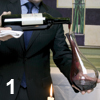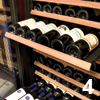Let it breathe
Why decant? A frequently asked question is, why do I need to decant wine? It is for two reasons: first, to aerate young wines; second, to remove deposit from older wines.
Young wines
The process of decanting (1) allows oxygen to react with the wine, helping it to release its flavours quicker. In young, robust, heavy red wines, this will soften the tannins and allow the fruit aromas to develop. After a wine is bottled it continues to breathe and develop using stored dissolved oxygen. This is technically known as "reductive" because, as the oxygen is used up, the potential for further development is reduced.
Reductive smells can be detected in young wines from barrel or bottle and are of a slightly volatile, green-cabbage character. This develops when the wine has begun to age in an anaerobic environment (ie, without oxygen), so allowing oxygen back into the wine opens it up and creates a blossoming effect with the aromas.
This is more likely to be necessary for wines of one to four years of age, depending on the style of the wine. Roughly, the heavier and more tannic the wine, the better it will benefit from aerating. Cabernet Sauvignon, Merlot, Sangiovese and especially Syrah/Shiraz are often decanted young, whereas Pinot Noir and Gamay styles are not. The decanting of white wines is also valuable for the same reason of developing aromas - fine white Burgundy being the most common, but all complex wine will benefit.
Older wines
As white wines age they develop colour, moving from pale green to a deep gold through an oxidative process similar to the browning effect found in cut fruit. Red wines, however, lose colour as they age, changing from a deep purple (2) to a mahogany-rimmed brick-red colour (3). Depending again on the style of wine, it may develop a deposit when reaching the five- to six-year-old stage.
Anthocyanins and polyphenols found in tannin - from pips, skins and stalks - give red wines their colour. With time, these chains of "colour" molecules join together and become longer until, eventually, unable to be held in the liquid, they fall as solid matter. This is why a red wine fades with age and a deposit forms.
There does come a time when the decanting of some old wines may be harmful to the delicate liquid held in the bottle. Some aromas and structure may be lost if the wine is decanted too far in advance of serving. But some flavours may never develop if not decanted early enough. There is no sure guide to this; it depends on many factors, including the style of the wine, the vintage, the winemaker's experience, and previous storage conditions.
In general, with wines in excess of 20 years old, the best advice is to open the wine carefully, take a small taste and decide when to decant. If you find the wine is in balance - with soft fruit, not aggressive tannins, and a complex, mature aroma - it will probably not benefit from too much oxygen. Swirling in the glass will achieve this, so decant at the last minute.
If the wine's aroma is quite closed, metallic ironstone, very mushroom-like or like damp dog hair, then decant earlier. People are often afraid when it comes to decanting old wine, but old wines can be very robust if they're from great vintages. Michael Broadbent (ex-Christie's) speaks of decanting the wonderful Mouton-Rothschild 1945 many hours in advance.
Cellaring
Ideally, a cellar should be dimly lit, with 60-80% humidity, free from vibration, have a small amount of ventilation and maintain a steady temperature. The main purpose of a cellar is to store wine safely and in an environment where slow, gentle ageing can occur and the components of acidity, tannin and fruit can develop and integrate.
The lower the temperature, the longer wines will take to mature. For example, wines held at 9°C will age much more slowly than wines held in a cellar at 15°C. Large temperature swings are to be avoided, so don't locate cellars in areas with hot-water boilers or pipes that are on and off regularly, or against outside walls that trap a lot of sunshine in summer and frost in winter. Seepage of wine around the neck capsule will indicate temperature fluctuations. Store bottles horizontally, so the corks are kept wet by the wine (4). For long-term storage, remove any tissue paper from the bottles and protect the labels from damp with clingfilm or hairspray.
Some cellars may have warmer or cooler areas, so try to arrange your wines according to serving temperature. For example, store white, full-bodied wine in less-cool areas of the cellar and crisp, fresh white near the chilling device. Also, in mixed cellars, try to store reds at the top and whites on the bottom, if possible, as heat rises. A useful piece of equipment is a combined thermometer/hygrometer that shows temperature and humidity levels. Buckets of wet sand can be used to increase humidity levels if necessary.
Temperature
When serving wine, one of the most important factors to get right is the temperature. Cool temperatures accentuate acidity and tannin while deadening the release of volatile flavour compounds, while warm temperatures accentuate sugar and alcohol and increase the release of volatiles. Often, white wines are served too cold - domestic fridges set at 6°C are far too cold - making the wines taste flavourless and sharp. Red wines served too warm taste alcoholic and soupy. We can manipulate the serving temperature of wine in certain ways.
For example, at Gordon Ramsay in Royal Hospital Road, we have a white-wine cellar that is kept at about 10°C, plus fridges for some sweet wines and Champagnes at about 6°C. Some wines are perfect when served direct from the cellar, while others need to be warmer or cooler. Sweet wines, crisp, fresh New World Sauvignons or German Rieslings need to be served slightly cooler, at about 8°C. As wine will drop in temperature by about 1°C for every four minutes, it is immersed in an ice bucket comprising one-third ice and two-thirds water (5). You should, ideally, leave the bottle for about eight to 10 minutes before serving if the customer has an aperitif; or serve a small amount and return to the ice if he or she does not.
You also need to consider that when wine is poured into a glass it will increase its temperature by at least 1°C quite quickly. Try not to leave wine sitting in an ice bucket for too long as this will bring the temperature down to about 2-4°C and leave the wine flavourless. You can leave white wine on the table on a coaster and perhaps return it to the ice bucket occasionally for a few minutes to maintain its freshness.
With white wines that are complex and full-bodied or mature - such as good white Burgundy or northern Rhône whites - you need to serve the wine at about 12-14°C. You can bring it to this state by decanting it into a carafe at room temperature and leaving the wine out of the ice.
In the restaurant you can see when the sommelier has over-chilled white wine by observing the amount of condensation on the outside of the glass: thick, heavy, beaded condensation shows the wine is too cold and below 7°C; light condensation that gives a smoky coating is about 9°C; while no condensation indicates about 11°C.
Red wines are served at about 14-18°C - the lighter, soft-tannin styles slightly cooler, and the heavier, full-bodied reds at a higher temperature. The outside of the glass into which you are pouring should feel slightly cool to the touch. Wines stored in a warm restaurant are often served at room temperature, which can be as high as 22°C. Don't be afraid to put red wines in an ice bucket for a few minutes or to decant and then briefly ice them.
In the wine service area, it is always useful to have a wine thermometer and to train staff to understand the changes temperature can have on taste. Try giving them a complex white wine served at 12°C next to a glass of the same wine served at 6°C and see what differences they can observe.
Lastly, remember that, as always, customer preferences prevail. If some people like their wines very cold or warmer than we would ideally like to serve, this can be an occasion when the sommelier's skill in diplomacy and tact can come into play by suggesting that they try a new experience.












